Global Solar Radiation Transfer and Its Loss in the Atmosphere
Abstract
1. Introduction
2. Data and Methodology
2.1. Observations and Data Selection
2.2. Model Formulation
- 1.
- The absorption term: absorption and use of global solar radiation by GLPs, including:
- (a)
- GLPs at wavelengths in the 290–400 nm region, when they participate in chemical and photochemical reactions (CPRs), with emphasis on volatile organic compounds (VOCs) through OH radicals and H2O
- (b)
- GLPs at wavelengths in the 400–700 nm region, when they participate in CPRs through OH radicals and H2O
- (c)
- H2O and other GLPs at wavelengths in the near-infrared (NIR) region (700–3200 nm)
A detailed introduction to OH production mechanisms at wavelengths in the UV and visible regions is given in [22,23,24,25,26,27] and the references in these papers. The fraction of global solar radiation absorbed by water vapor in the wavelength region of 0.70–2.85 μm is expressed as △S’ = 0.17 (mW)0.30 [28]; the total water vapor content in the atmospheric column (cm), W = 0.02E × 30 [22]; and E is the average water vapor pressure (hPa) at the ground. If only water vapor is considered and the atmosphere is plane-parallel, the solar radiation on the horizontal surface can be described asI0 cos Z − ΔS’= I0e−kWm × cos(Z)where I0 = 1.94 cal min−1 cm−2 (=1367 W m−2) is the solar constant, k is the average absorption coefficient of water vapor in 0.70–2.85 μm, and m is the optical air mass in the middle of each hour. The absorption term at the horizontal plane is expressed as e−kWm × cos(Z).e−kWm=1 − ΔS’/Io - 2.
- The scattering term: Scattering of solar radiation by GLPs in the atmosphere is assumed to vary exponentially with S/G, i.e., e−S/G, where S/G is a normalized parameter that objectively represents the total scattering by atmospheric GLPs in the atmospheric column, including molecules, particles, clouds, haze, and water vapor [22].
2.3. Determination and Evaluation of Model Coefficients for the Qianyanzhou Subtropical Site
3. Results
3.1. Seasonal Variation in Global Solar Irradiance Losses Due to GLP Extinction
3.2. Variations in Global Solar Irradiance and Their Losses in the Atmosphere
3.3. Extinction Factor and Related Estimation of Solar Radiation
3.4. Sensitivity Test
3.5. Correlations between Some Parameters and Related Mechanisms
3.6. Estimation of Aerosol Optical Depth (AOD)
4. Discussions
4.1. Empirical Model and Estimation of Global Solar Irradiance
4.2. Extinction Factor and the AOD
4.3. Relative Contributions of Absorbing and Scattering Terms
4.4. The Meaning of the Absorbing Term
4.5. The Comparison of Albedo
4.6. Seasonal Losses of Global Solar Irradiance Due to GLP Extinction
5. Conclusions
Author Contributions
Funding
Institutional Review Board Statement
Data Availability Statement
Acknowledgments
Conflicts of Interest
References
- Madronich, S.; Flocke, S. The Role of Solar Radiation in Atmospheric Chemistry. In Environmental Photochemistry, Vol. 2/2L of the Handbook of Environmental Chemistry; Boule, P., Ed.; Springer: Berlin/Heidelberg, Germany, 1999; pp. 1–26. [Google Scholar]
- Solanki, S.K. Solar variability and climate change is there a link. Astron. Geophys. 2002, 43, 5.9–5.13. [Google Scholar] [CrossRef]
- Elminir, H.K. Relative influence of weather conditions and air pollutants on solar radiation—Part 2: Modification of solar radiation over urban and rural sites. Meteorol. Atmos. Phys. 2007, 96, 257–264. [Google Scholar] [CrossRef]
- Trenberth, K.E.; Fasullo, J.T.; Kiehl, J. Earth’s global energy budget. Bull. Am. Meteorol. Soc. 2009, 90, 311–323. [Google Scholar] [CrossRef]
- Lean, J.; Rind, D. Climate forcing by changing solar radiation. J. Clim. 2010, 11, 3069–3094. [Google Scholar] [CrossRef]
- Andreae, M.O.; Ramanathan, V. Climate’s Dark Forcings. Sciences 2013, 340, 280–281. [Google Scholar] [CrossRef]
- Rosenfeld, D.; Sherwood, S.; Wood, R.; Donner, L. Climate Effects of Aerosol-Cloud Interactions. Sciences 2014, 343, 379–380. [Google Scholar] [CrossRef]
- Calabrò, E.; Magazù, S. Correlation between Increases of the Annual Global Solar Radiation and the Ground Albedo Solar Radiation due to Desertification—A Possible Factor Contributing to Climatic Change. Climate 2016, 4, 64. [Google Scholar] [CrossRef]
- Glower, J.; McGulloch, J.S.G. The empirical relation between solar radiation and hours of sunshine. Q. J. R. Met. Soc. 1958, 84, 172–175. [Google Scholar]
- Atwater, M.A.; Ball, J.T. A numerical solar radiation model based on standard meteorological observations. Sol. Energy 1978, 21, 163–170, Erratum in Sol. Energy 1978, 123, 275. [Google Scholar] [CrossRef]
- Bird, R.E. A simple solar spectral model for direct-normal and diffuse horizontal irradiance. Sol. Energy 1984, 32, 461–471. [Google Scholar] [CrossRef]
- Gueymard, C.A. Critical analysis and performance assessment of clear sky solar irradiance models using theoretical and measured data. Sol. Energy 1993, 51, 121–138. [Google Scholar] [CrossRef]
- Gueymard, C.A. Clear-Sky Radiation Models and Aerosol Effects. Sol. Resour. Mapp. 2019, 137–182. [Google Scholar] [CrossRef]
- Myers, D.R. Solar radiation modeling and measurements for renewable energy applications data and model quality. Energy 2005, 30, 1517–1531. [Google Scholar] [CrossRef]
- Badescu, V.; Gueymard, C.A.; Cheval, S.; Oprea, C.; Baciu, M.; Dumitrescu, A.; Iacobescu, F.; Milos, I.; Rada, C. Accuracy analysis for fifty-four clear-sky solar radiation models using routine hourly global irradiance measurements in Romania. Renew. Energy 2013, 55, 85–103. [Google Scholar] [CrossRef]
- Besharat, F.; Dehghan, A.A.; Faghih, A. Empirical models for estimating global solar radiation: A review and case study. Renew. Sustain. Energy Rev. 2013, 21, 798–821. [Google Scholar] [CrossRef]
- Bayrakc, H.C.; Demircan, C.; Keceba, A. The development of empirical models for estimating global solar radiation on horizontal surface: A case study. Renew. Sustain. Energy Rev. 2018, 81, 2771–2782. [Google Scholar] [CrossRef]
- Antonanzas-Torres, F.; Urraca, R.; Polo, J.; Perpinan-Lamigueiro, O.; Escobar, R. Clear sky solar irradiance models: A review of seventy models. Renew. Sustain. Energy Rev. 2019, 107, 374–387. [Google Scholar] [CrossRef]
- Kosmopoulos, P.G.; Kazadzis, S.; Lagouvardos, K.; Kotroni, V.; Bais, A. Solar energy prediction and verification using operational model forecasts and ground-based solar measurements. Energy 2015, 93, 1918–1930. [Google Scholar] [CrossRef]
- Bai, J.H. UV extinction in the atmosphere and its spatial variation in North China. Atmos. Environ. 2017, 154, 318–330. [Google Scholar] [CrossRef]
- Bilbao, J.; Mateos, D.; De Miguel, A. Analysis and cloudiness influence on UV total irradiation. J. Climatol. 2011, 31, 451–460. [Google Scholar]
- Bai, J.H. Photosynthetically active radiation loss in the atmosphere in North China. Atmos. Pollut. Res. 2013, 4, 411–419. [Google Scholar] [CrossRef]
- Matthews, J.; Sinha, A.; Francisco, J.S. The importance of weak absorption features in promoting tropospheric radical production. Proc. Natl. Acad. Sci. USA 2005, 102, 7449–7452. [Google Scholar] [CrossRef] [PubMed]
- Li, S.P.; Matthews, J.; Sinha, A. Atmospheric hydroxyl radical production from electronically excited NO2 and H2O. Science 2008, 319, 1657–1660. [Google Scholar] [CrossRef]
- Bai, J.H. Analysis of ultraviolet radiation in clear skies in Beijing and its affecting factors. Atmos. Environ. 2011, 45, 6930–6937. [Google Scholar] [CrossRef]
- Du, J.; Huang, L.; Min, Q.; Zhu, L. The Influence of Water Vapor Absorption in the 290–350 nm Region on Solar Radiance: Laboratory Studies and Model Simulation. Geophys. Res. Lett. 2013, 40, 1–5. [Google Scholar] [CrossRef]
- Wilson, E.M.; Wenger, J.C.; Venables, D.S. Upper limits for absorption by water vapor in the near-UV. J. Quant. Spectrosc. Radiat. Transf. 2016, 170, 194–199. [Google Scholar] [CrossRef]
- Kondratyev, K.Y.A. Solar Energy; Science Press: Beijing, China, 1962; pp. 123–132. [Google Scholar]
- Yang, S.; Wang, X.L.; Wild, M. Causes of Dimming and Brightening in China Inferred from Homogenized Daily Clear-Sky and All-Sky in situ Surface Solar Radiation Records (1958–2016). J. Clim. 2019, 32, 5901–5913. [Google Scholar] [CrossRef]
- Sogacheva, L.; de Leeuw, G.; Rodriguez, E.; Kolmonen, P.; Georgoulias, A.K.; Alexandri, G.; Kourtidis, K.; Proestakis, E.; Marinou, E.; Amiridis, V.; et al. Spatial and seasonal variations of aerosols over China from two decades of multi-satellite observations—Part 1: ATSR (1995–2011) and MODIS C6.1 (2000–2017). Atmos. Chem. Phys. 2018, 18, 11389–11407. [Google Scholar] [CrossRef]
- Bai, J.; de Leeuw, G.; De Smedt, I.; Theys, N.; Van Roozendael, M.; Sogacheva, L.; Chai, W. Variations and photochemical transformations of atmospheric constituents in North China. Atmos. Environ. 2018, 189, 213–226. [Google Scholar] [CrossRef]
- Jacobson, M. Isolating nitrated and aromatic aerosols and nitrated aromatic gases as sources of ultraviolet light absorption. J. Geophys. Res. 1999, 104, 3527–3542. [Google Scholar] [CrossRef]
- Claeys, M.; Graham, B.; Vas, G.; Wang, W.; Vermeylen, R.; Pashynska, V.; Cafmeyer, J.; Guyon, P.; Andreae, M.O.; Artaxo, P.; et al. Formation of secondary organic aerosols through photooxidation of isoprene. Science 2004, 303, 1173–1176. [Google Scholar] [CrossRef] [PubMed]
- Jonsson, Å.M.; Hallquist, M.; Ljungström, E. Influence of OH Scavenger on the Water Effect on Secondary Organic Aerosol Formation from Ozonolysis of Limonene, Δ3-Carene, and α-Pinene. Environ. Sci. Technol. 2008, 42, 5938–5944. [Google Scholar] [CrossRef]
- Carlton, A.G.; Wiedinmyer, C.; Kroll, J.H. A review of secondary organic aerosol (SOA) formation from isoprene. Atmos. Chem. Phys. 2009, 9, 4987–5005. [Google Scholar] [CrossRef]
- Bai, J.H.; Guenther, A.; Turnipseed, A.; Duhl, T.; Greenberg, J. Seasonal and interannual variations in whole-ecosystem BVOC emissions from a subtropical plantation in China. Atmos. Environ. 2017, 161, 176–190. [Google Scholar] [CrossRef]
- Hansel, A.K.; Ehrenhauser, F.S.; Richards-Henderson, N.K.; Anastasio, C.; Valsaraj, K.T. Aqueous-phase oxidation of green leaf volatiles by hydroxyl radical as a source of SOA: Product identification from methyl jasmonate and methyl salicylate oxidation. Atmos. Environ. 2015, 102, 43–51. [Google Scholar] [CrossRef]
- Salomonson, V.V.; Barnes, W.L.; Maymon, P.W.; Montgomery, P.W.; Ostrow, H. MODIS: Advanced facility instrument for studies of the Earth as a system. IEEE Trans. Geosci. Remote Sens. 1989, 27, 145–153. [Google Scholar] [CrossRef]
- Hsu, N.C.; Tsay, S.C.; King, M.D.; Herman, J.R. Aerosol properties over bright-reflecting source regions. IEEE Trans. Geosci. Remote Sens. 2004, 42, 557–569. [Google Scholar] [CrossRef]
- Remer, L.A.; Kaufman, Y.J.; Tanré, D.; Mattoo, S.; Chu, D.A.; Martins, J.V.; Li, R.R.; Ichoku, C.; Levy, R.C.; Kleidman, R.G.; et al. The MODIS Aerosol Algorithm, Products, and Validation. J. Atmos. Sci. 2005, 62, 947–973. [Google Scholar] [CrossRef]
- Sayer, A.M.; Munchak, L.A.; Hsu, N.C.; Levy, R.C.; Bettenhausen, C.; Jeong, M.J. MODIS Collection 6 aerosol products: Comparison between Aqua’s e-Deep Blue, Dark Target, and “merged” data sets, and usage recommendations. J. Geophys. Res. Atmos. 2014, 119, 13965–13989. [Google Scholar] [CrossRef]
- Levy, R.C.; Mattoo, S.; Munchak, L.A.; Remer, L.A.; Sayer, A.M.; Patadia, F.; Hsu, N.C. The Collection 6 MODIS aerosol products over land and ocean. Atmos. Meas. Tech. 2013, 6, 2989–3034. [Google Scholar] [CrossRef]
- Yang, H. Analysis on climate change feature of Beijing during 1951 to 2006. Beijing Water 2013, 3, 36–40. [Google Scholar]
- Zhang, Y.X.; Song, M.; Yang, Y.J. The change characteristic of temperature and precipitation in the North China during 1956 and 2011. J. Anhui Agric. Sci. 2013, 4, 41726–41728. [Google Scholar]
- Rong, Y.Q.; Liang, J.Y. Analysis of variation of wind speed over north China. Sci. Meteorol. Sin. 2015, 28, 655–658. [Google Scholar]
- Jacobson, M.Z. Strong radiative heating due to the mixing state of black carbon in atmospheric aerosols. Nature 2001, 409, 695–697. [Google Scholar] [CrossRef]
- Menon, S.; Hansen, J.; Nazarenko, L.; Luo, Y.F. Climate effects of black carbon aerosols in China and India. Science 2002, 297, 2250–2253. [Google Scholar] [CrossRef]
- Ma, Q.R.; You, Q.L.; Cai, M.; Zhou, Y.Q.; Liu, J.J. The cloud variation over China in recent 15 years based on CERES satellite data. J. Arid Meteorol. 2018, 36, 911–920. [Google Scholar]
- Ehn, M.; Thornton, J.A.; Kleist, E.; Sipilä, M.; Junninen, H.; Pullinen, I.; Springer, M.; Rubach, F.; Tillmann, R.; Lee, B.; et al. A large source of low-volatility secondary organic aerosol. Nature 2014, 506, 476–479. [Google Scholar] [CrossRef] [PubMed]
- McVay, R.C.; Zhang, X.; Aumont, B.; Valorso, R.; Camredon, M.; La, Y.Y.S.; Wennberg, P.O.; Seinfeld, J.H. SOA formation from the photooxidation of α-pinene: Systematic exploration of the simulation of chamber data. Atmos. Chem. Phys. 2016, 16, 2785–2802. [Google Scholar] [CrossRef]
- Dunne, E.M.; Gordon, H.; Kürten, A.; Almeida, J.; Duplissy, J.; Williamson, C.; Ortega, I.K.; Pringle, K.J.; Adamov, A.; Baltensperger, U.; et al. Global atmospheric particle formation from CERN CLOUD. Science 2016, 354, 1119–1124. [Google Scholar] [CrossRef] [PubMed]
- Atkinson, R. Atmospheric chemistry of VOCs and NOx. Atmos. Environ. 2000, 34, 2063–2101. [Google Scholar] [CrossRef]
- Kirchstetter, T.W.; Novakov, T.; Hobbs, P.V. Evidence that the spectral dependence of light absorption by aerosols is affected by organic carbon. J. Geophys. Res. 2004, 109, D21208. [Google Scholar] [CrossRef]
- Hoffer, A.; Gelencs’er, A.; Guyon, P.; Kiss, G.; Schmidt, O.; Frank, G.P.; Artaxo, P.; Andreae, M.O. Optical properties of humic-like substances (HULIS) in biomass burning aerosols. Atmos. Chem. Phys. 2006, 6, 3563–3570. [Google Scholar] [CrossRef]
- Wild, M.; Gilgen, H.; Roesch, A.; Ohmura, A.; Long, C.; Dutton, E.; Forgan, B.; Kallis, A.; Russak, V.; Tsvetkov, A. From dimming to brightening: Decadal changes in solar radiation at the Earth’s surface. Science 2005, 308, 847–850. [Google Scholar] [CrossRef]
- Wang, Y.W.; Yang, Y.H. China’s dimming and brightening: Evidence, causes and hydrological implications. Ann. Geophys. 2014, 32, 1–15. [Google Scholar] [CrossRef]
- Qiu, J. A Method to Determine Atmospheric Aerosol Optical Depth Using Total Direct Solar Radiation. J. Atmos. Sci. 1998, 55, 744–757. [Google Scholar] [CrossRef]
- Xu, X.; Qiu, J.; Xia, X.; Sun, L.; Min, M. Characteristics of atmospheric aerosol optical depth variation in China during 1993–2012. Atmos. Environ. 2015, 119, 82–94. [Google Scholar] [CrossRef]
- Lampel, J.; Pöhler, D.; Polyansky, O.; Kyuberis, A.A.; Zobov, N.F.; Tennyson, J.; Lodi, L.; Frieß, U.; Wang, Y.; Beirle, S.; et al. Detection of water vapour absorption around 363 nm in measured atmospheric absorption spectra and its effect on DOAS evaluations. Atmos. Chem. Phys. 2017, 17, 1271–1295. [Google Scholar] [CrossRef]
- Meller, R.; Moortgat, G.K. Temperature dependence of the absorption cross sections of formaldehyde between 223 and 323 K. J. Geophys. Res. 2000, 105, 7089–7101. [Google Scholar] [CrossRef]
- Horowitz, A.; Meller, R.; Moortgat, G.K. The UV-VIS absorption cross sections of the α- dicarbonyl compounds: Pyruvic acid, biacetyl and glyoxal. J. Photochem. Photobiol. A Chem. 2001, 146, 19–27. [Google Scholar] [CrossRef]
- Adamopoulos, A.D.; Kambezidis, H.D.; Zevgolis, D. Total atmospheric transmittance in the ultraviolet and visible spectra in Athens, Greece. Pure Appl. Geophys. 2005, 162, 409–431. [Google Scholar] [CrossRef]
- Kirchstetter, T.W.; Thatcher, T.L. Contribution of organic carbon to wood smoke particulate matter absorption of solar radiation. Atmos. Chem. Phys. 2012, 12, 6067–6072. [Google Scholar] [CrossRef]
- Desyaterik, Y.; Sun, Y.; Shen, X.; Lee, T.; Wang, X.; Wang, T.; Collett, J. Speciation of “brown” carbon in cloud water impacted by agricultural biomass burning in Eastern China. J. Geophys. Res. Atmos. 2013, 118, 7389–7399. [Google Scholar] [CrossRef]
- Laskin, A.; Laskin, J.; Nizkorodov, S.A. Chemistry of atmospheric brown carbon. Chem. Rev. 2015, 115, 4335–4382. [Google Scholar] [CrossRef]
- Deluisi, J.J. Spectral absorption of solar radiation by the denver brown (pollution) cloud. Atmos. Environ. 1977, 11, 829–836. [Google Scholar] [CrossRef]
- Harley, P.C. The Roles of Stomatal Conductance and Compound Volatility in Controlling the Emission of Volatile Organic Compounds from Leaves. In Biology, Controls and Models of Tree Volatile Organic Compound Emissions; Niinemets, Ü., Monson, R.K., Eds.; Tree Physiology, 5; Springer: Dordrecht, The Netherlands; New York, NY, USA, 2013; pp. 181–208. [Google Scholar]
- Kiendler-Scharr, A.; Wildt, J.; Dal Maso, M.; Hohaus, T.; Kleist, E.; Mentel, T.F.; Tillmann, R.; Uerlings, R.; Schurr, U.; Wahner, A. New particle formation in forests inhibited by isoprene emissions. Nature 2009, 461, 381–384. [Google Scholar] [CrossRef]
- Mielonen, T.; Hienola, A.; Kühn, T.; Merikanto, J.; Lipponen, A.; Bergman, T.; Korhonen, H.; Kolmonen, P.; Sogacheva, L.; Ghent, D.; et al. Summertime Aerosol Radiative Effects and Their Dependence on Temperature over the Southeastern USA. Atmosphere 2018, 9, 180. [Google Scholar] [CrossRef]
- Penuelas, J.; Llusia, J. BVOCs: Plant defense against climate warming? Trends Plant Sci. 2003, 8, 105–109. [Google Scholar] [CrossRef]
- Maria, Z.H.; Folini, D.; Wild, M.; Long, C.N.; Schaepman-Strub, G.; Stephens, G.L. Cloud Effects on Atmospheric Solar Absorption in Light of Most Recent Surface and Satellite Measurements. AIP Conf. Proc. 2017, 1810, 090003. [Google Scholar]
- Kulmala, M.; Suni, T.; Lehtinen, K.E.J.; Maso, M.D.; Boy, M.; Reissell, A.; Rannik, U.; Aalto, P.; Keronen, P.; Hakola, H.; et al. A new feedback mechanism linking forests, aerosols, and climate. Atmos. Chem. Phys. 2004, 4, 557–562. [Google Scholar] [CrossRef]
- Jokinen, T.; Berndt, T.; Makkonen, R.; Kerminen, V.M.; Junninen, H.; Paasonen, P.; Stratmann, F.; Herrmann, H.; Guenther, A.B.; Worsnop, D.R.; et al. Production of extremely low volatile organic compounds from biogenic emissions Measured yields and atmospheric implications. Proc. Natl. Acad. Sci. USA 2015, 112, 7123–7128. [Google Scholar] [CrossRef]
- Dall’Osto, M.; Beddows, D.C.S.; Asmi, A.; Poulain, L.; Hao, L.; Freney, E.; Allan, J.D.; Canagaratna, M.; Crippa, M.; Bianchi, F.; et al. Novel Insights on New Particle Formation Derivedfrom a Pan-European Observing System. Sci. Rep. 2018, 8, 1482. [Google Scholar] [CrossRef] [PubMed]
- Chu, B.; Kerminen, V.M.; Bianchi, F.; Yan, C.; Petäjä, T.; Kulmala, M. Atmospheric new particle formation in China. Atmos. Chem. Phys. 2019, 19, 115–138. [Google Scholar] [CrossRef]
- Dickinson, R.E. Land surface processes and climate surface albedos and energy balance. Adv. Geophys. 1983, 25, 305–353. [Google Scholar]
- Li, Z.Q.; Garand, L. Estimation of Surface Albedo from Surface—A Parameterization for Global Application. J. Geophys. Res. 1994, 99, 8335–8350. [Google Scholar] [CrossRef]
- Psiloglou, B.E.; Kambezidis, H.D. Estimation of the ground albedo for the Athens area, Greece. J. Atmos. Sol.-Terr. Phys. 2009, 71, 943–954. [Google Scholar] [CrossRef]
- Loeb, N.G.; Doelling, D.R.; Wang, H.; Su, W.; Nguyen, C.; Corbett, J.G.; Liang, L.; Mitrescu, C.; Rose, F.G.; Kato, S. Clouds and the Earth’s Radiant Energy System (CERES) Energy Balanced and Filled (EBAF) Top-of-Atmosphere (TOA) Edition 4.0 Data Product. J. Clim. 2018, 31, 895–918. [Google Scholar] [CrossRef]
- Kato, S.; Rose, F.G.; Rutan, D.A.; Thorsen, T.J.; Loeb, N.G.; Doelling, D.R.; Huang, X.; Smith, W.L.; Su, W.; Ham, S.H. Surface Irradiances of Edition 4.0 Clouds and the Earth’s Radiant Energy System (CERES) Energy Balanced and Filled (EBAF) Data Product. J. Clim. 2018, 31, 4501–4527. [Google Scholar] [CrossRef]
- Sun, Y.J.; Wang, Z.H.; Qin, Q.M.; Han, G.H.; Ren, H.Z.; Huang, J.F. Retrieval of surface albedo based on GF-4geostationary satellite image data. J. Remote Sens. 2018, 22, 220–233. [Google Scholar]
- Valero, F.P.J.; Pope, S.K.; Bush, B.C.; Nguyen, Q.; Marsden, D.; Cess, R.D.; Simpson-Leitner, A.S.; Bucholtz, A.; Udelhofen, P.M. Absorption of solar radiation by the clear and cloudy atmosphere during the Atmospheric Radiation Measurement Enhanced Shortwave Experiments (ARESE) I and II: Observations and models. J. Geophys. Res. 2013, 108, 4016. [Google Scholar] [CrossRef]
- Shen, Z.B.; Wang, Y.Q.; Wang, W.H.; Wu, J.Z. The attenuation of solar radiation in the polluted urban atmosphere. Plateau Meteorol. 1982, 1, 74–83. [Google Scholar]
- Sweerts, B.; Pfenninger, S.; Yang, S.; Folini, D.; van der Zwaan, B.; Wild, M. Estimation of losses in solar energy production from air pollution in China since 1960 using surface radiation data. Nat. Energy 2019, 4, 657–663. [Google Scholar] [CrossRef]
- Von Schuckmann, K.; Palmer, M.D.; Trenberth, K.E.; Cazenave, A.; Chambers, D.; Champollion, N.; Hansen, J.; Josey, S.A.; Loeb, N.; Mathieu, P.-P.; et al. An imperative to monitor Earth’s energy imbalance. Nat. Clim. Chang. 2016, 6, 138–144. [Google Scholar] [CrossRef]
- Guyon, P.; Graham, B.; Roberts, G.C.; Mayol-Bracero, O.L.; Maenhaut, W.; Artaxo, P.; Andreae, M.O. Sources of optically active aerosol particles over the Amazon forest. Atmos. Environ. 2004, 38, 1039–1051. [Google Scholar] [CrossRef]
- Sun, Y.; Jiang, Q.; Xu, Y.; Ma, Y.; Zhang, Y.; Liu, X.; Li, W.; Wang, F.; Li, J.; Wang, P.; et al. Aerosol characterization over the North China Plain: Haze life cycle and biomass burning impacts in summer. J. Geophys. Res. 2016, 121, 2508–2521. [Google Scholar] [CrossRef]
- Xu, W.; Xie, C.; Karnezi, E.; Zhang, Q.; Wang, J.; Pandis, S.N.; Ge, X.; Zhang, J.; An, J.; Wang, Q.; et al. Summertime aerosol volatility measurements in Beijing, China. Atmos. Chem. Phys. 2019, 19, 10205–10216. [Google Scholar] [CrossRef]
- Chen, C.; Park, T.; Wang, X.; Piao, S.; Xu, B.; Chaturvedi, R.K.; Fuchs, R.; Brovkin, V.; Ciais, P.; Fensholt, R.; et al. China and India lead in greening of the world through land- use management. Nat. Sustain. 2019, 2, 122–129. [Google Scholar] [CrossRef]
- Psiloglou, B.E.; Kambezidis, H.D.; Kaskaoutis, D.G.; Karagiannis, D.; Polo, J.M. Comparison between MRM simulations, CAMS and PVGIS databases with measured solar radiation components at the Methoni station, Greece. Renew. Energy 2020, 146, 1372–1391. [Google Scholar] [CrossRef]
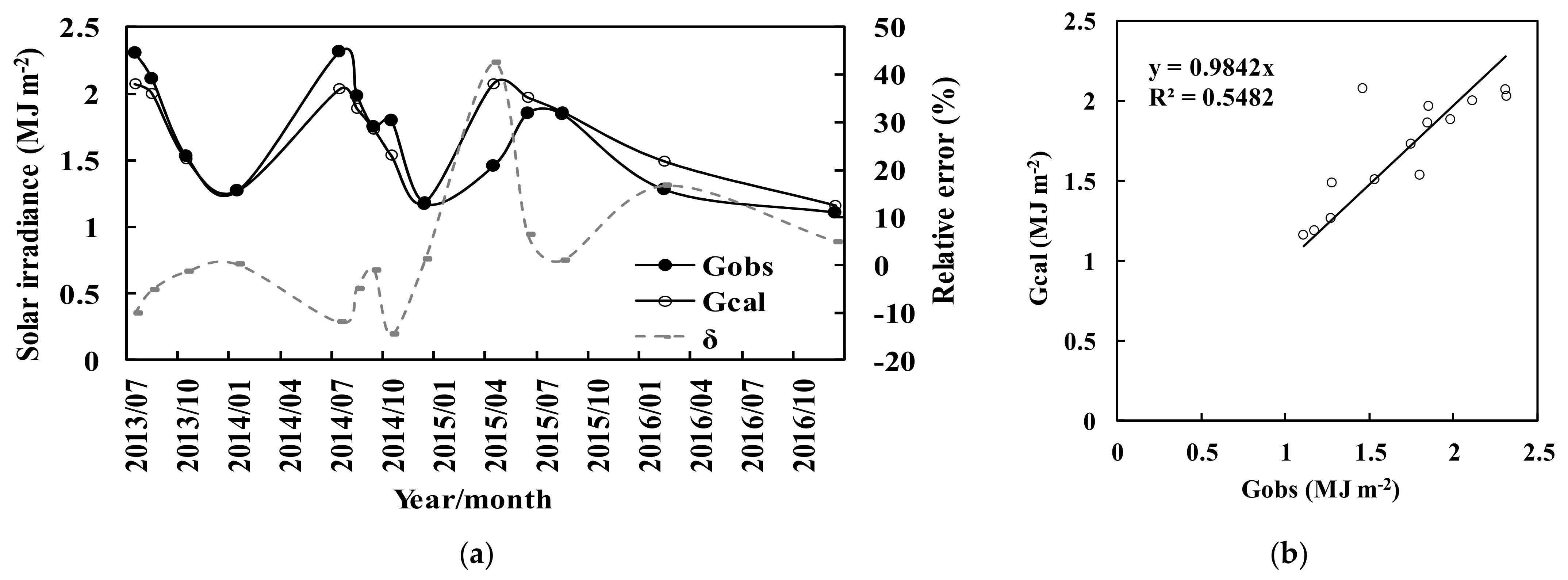
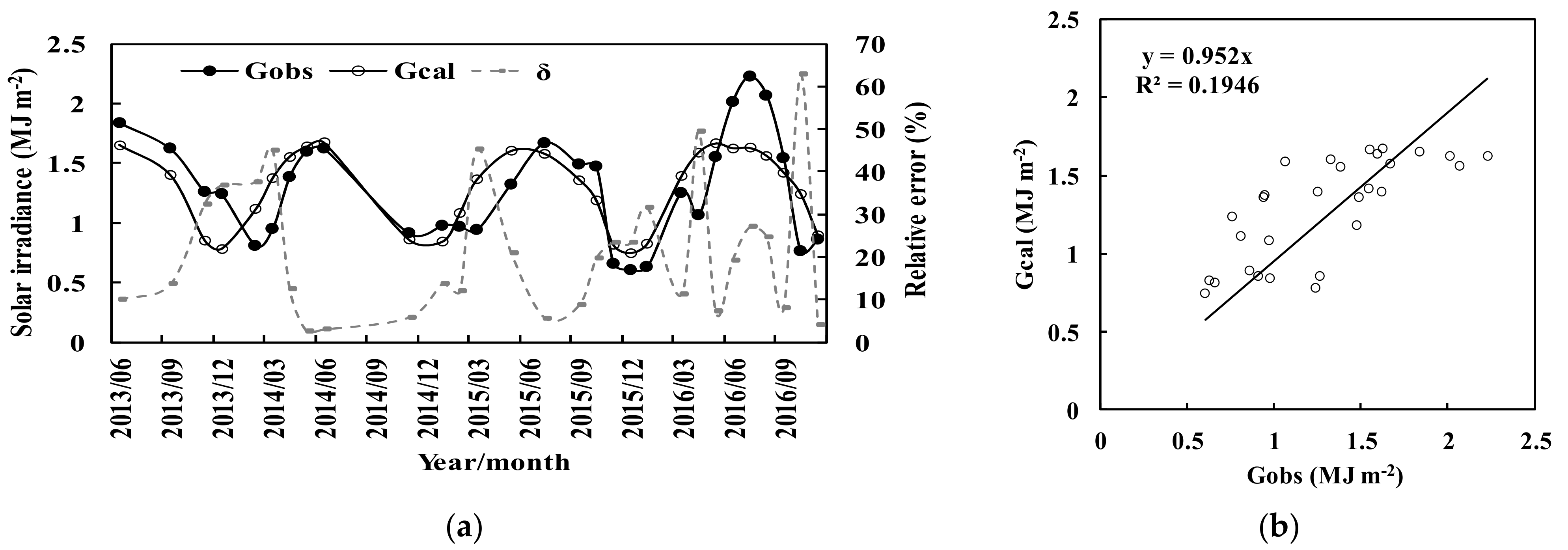
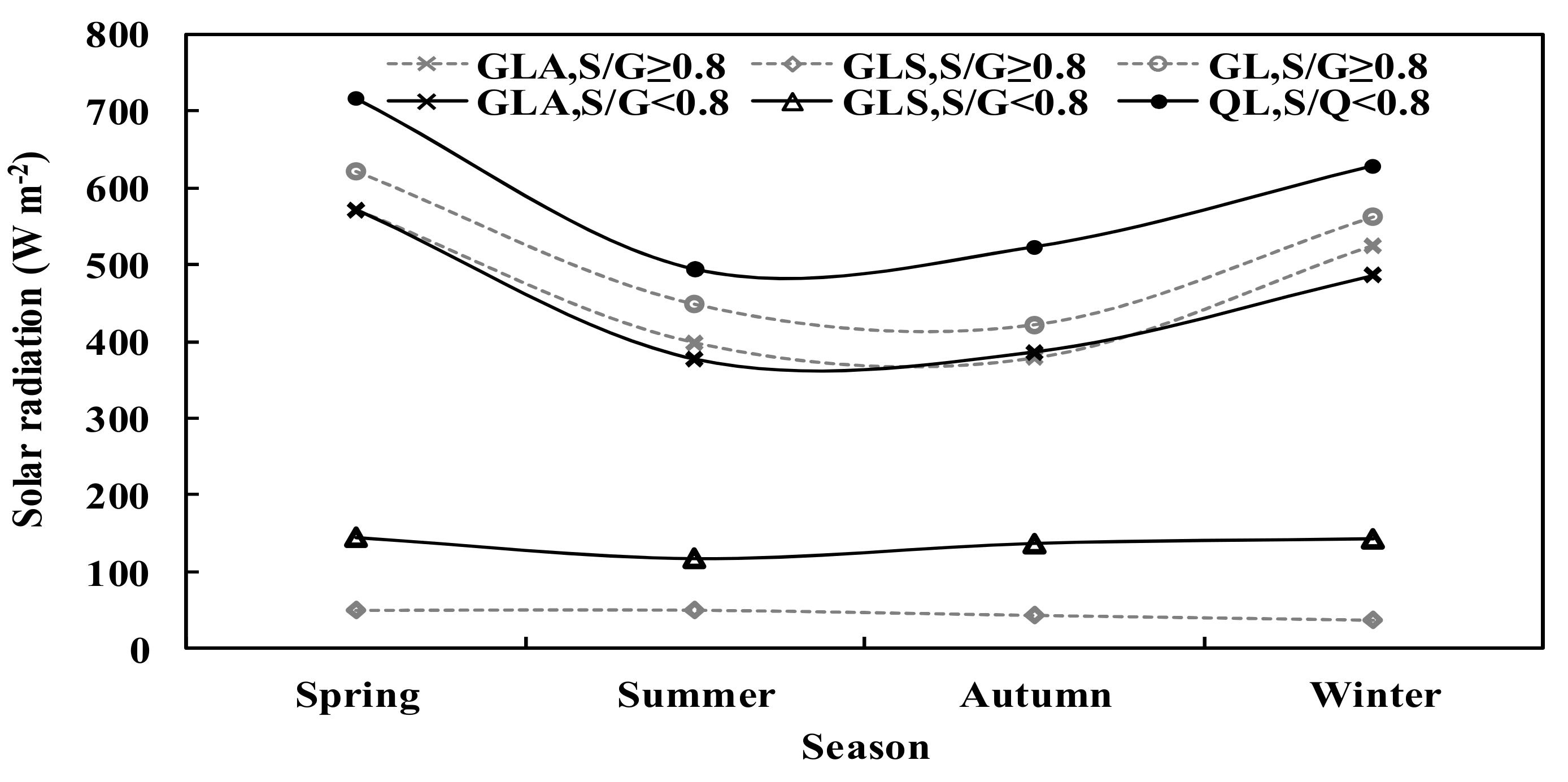
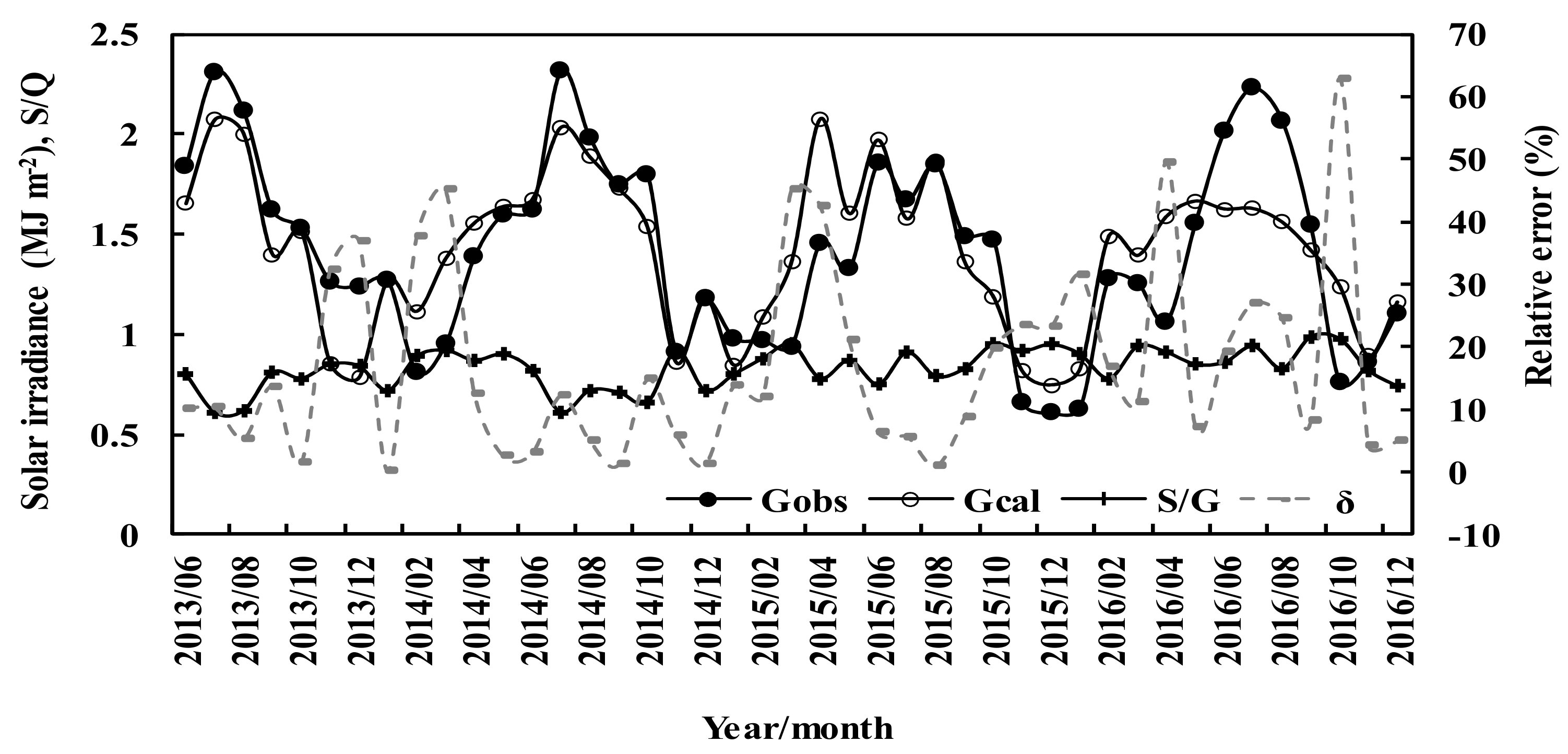
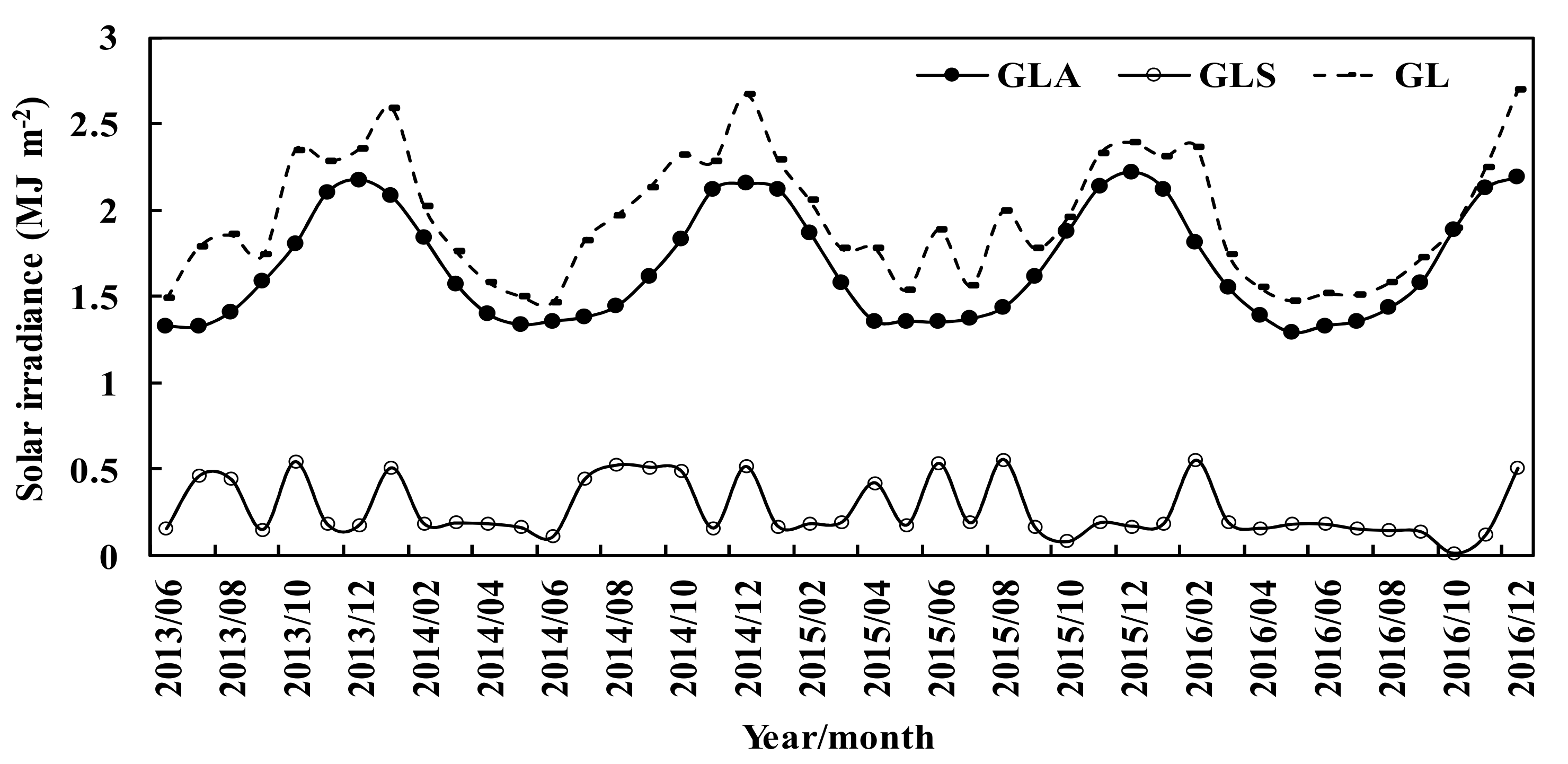
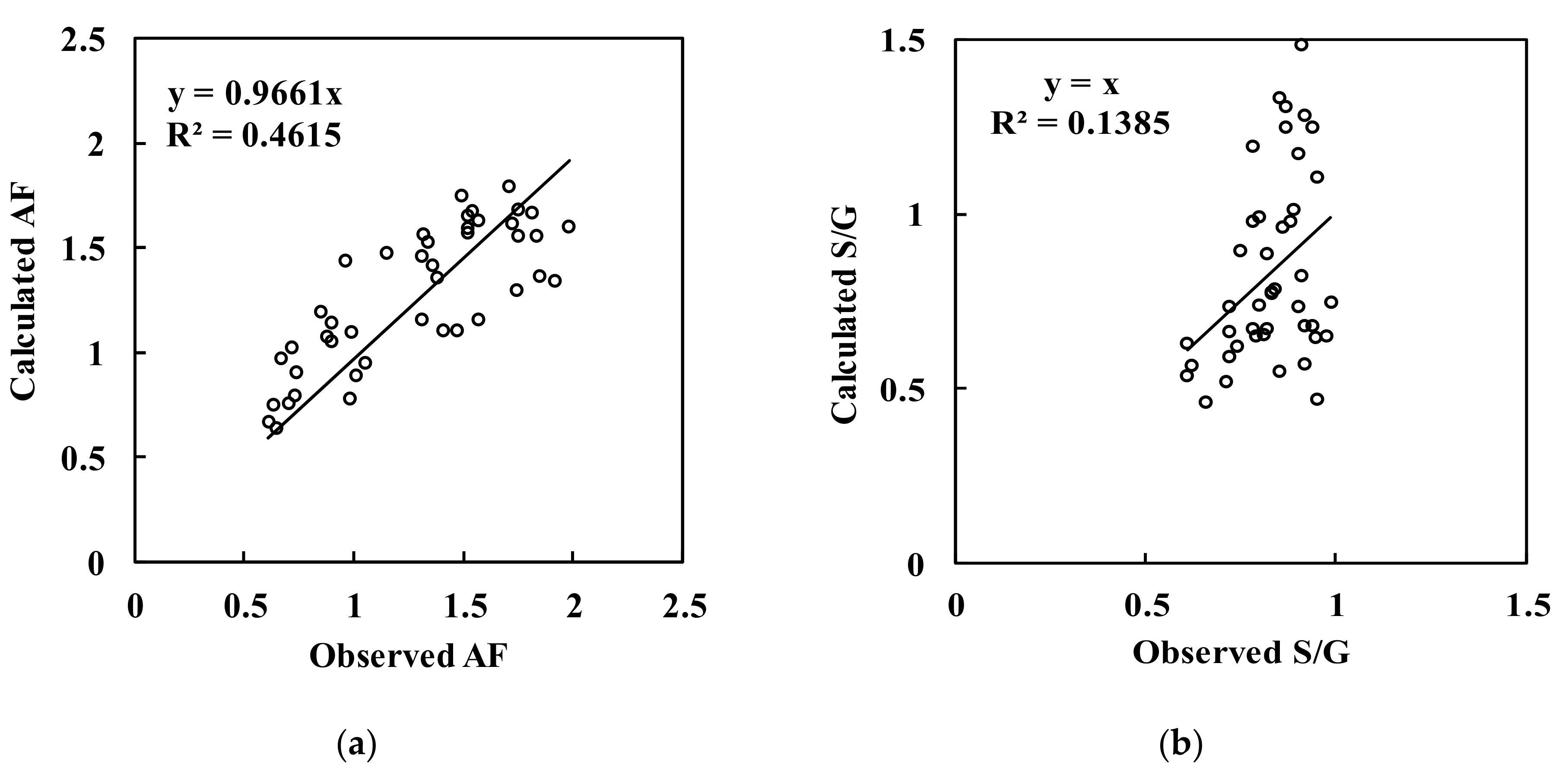
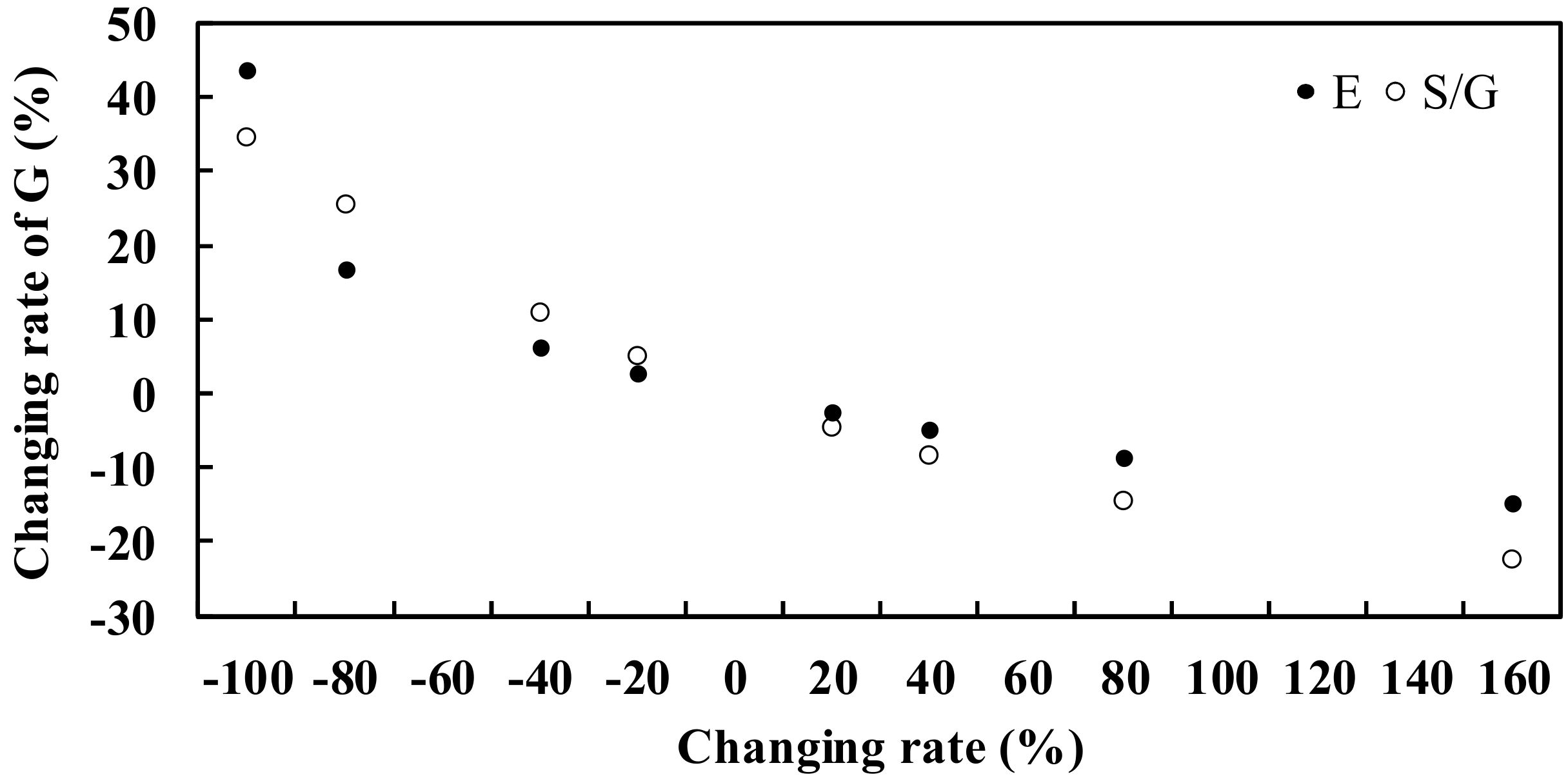
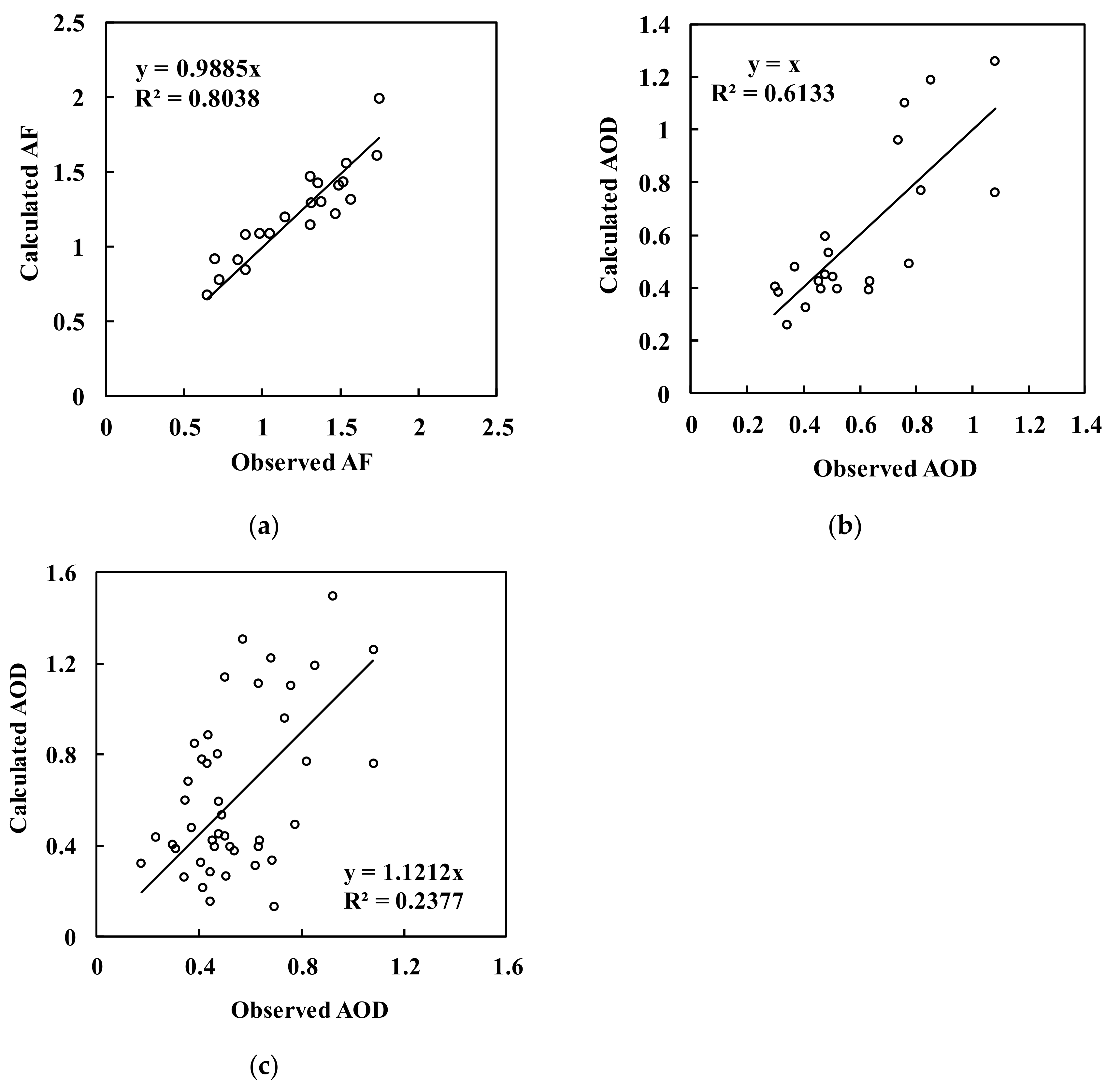
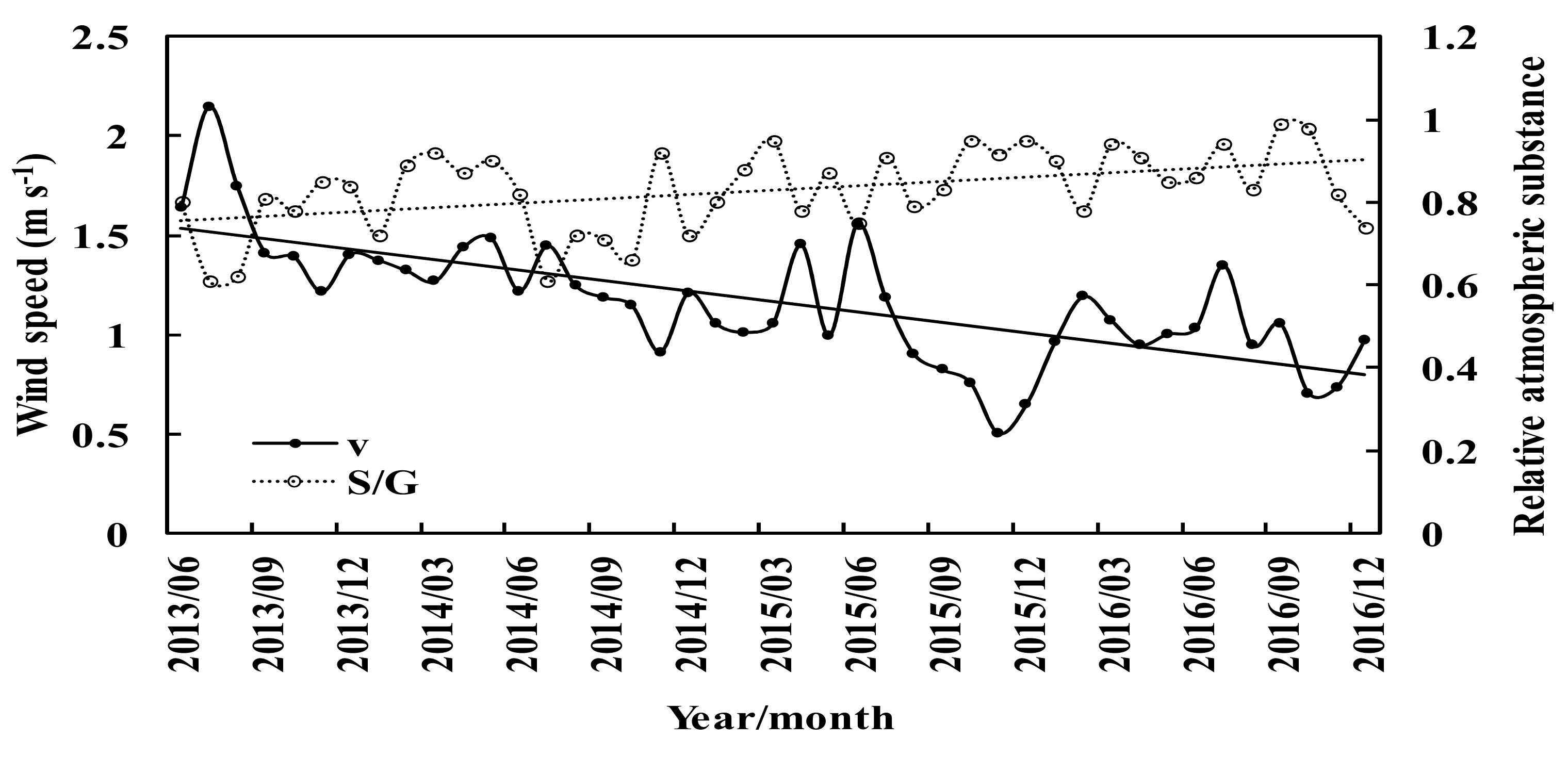

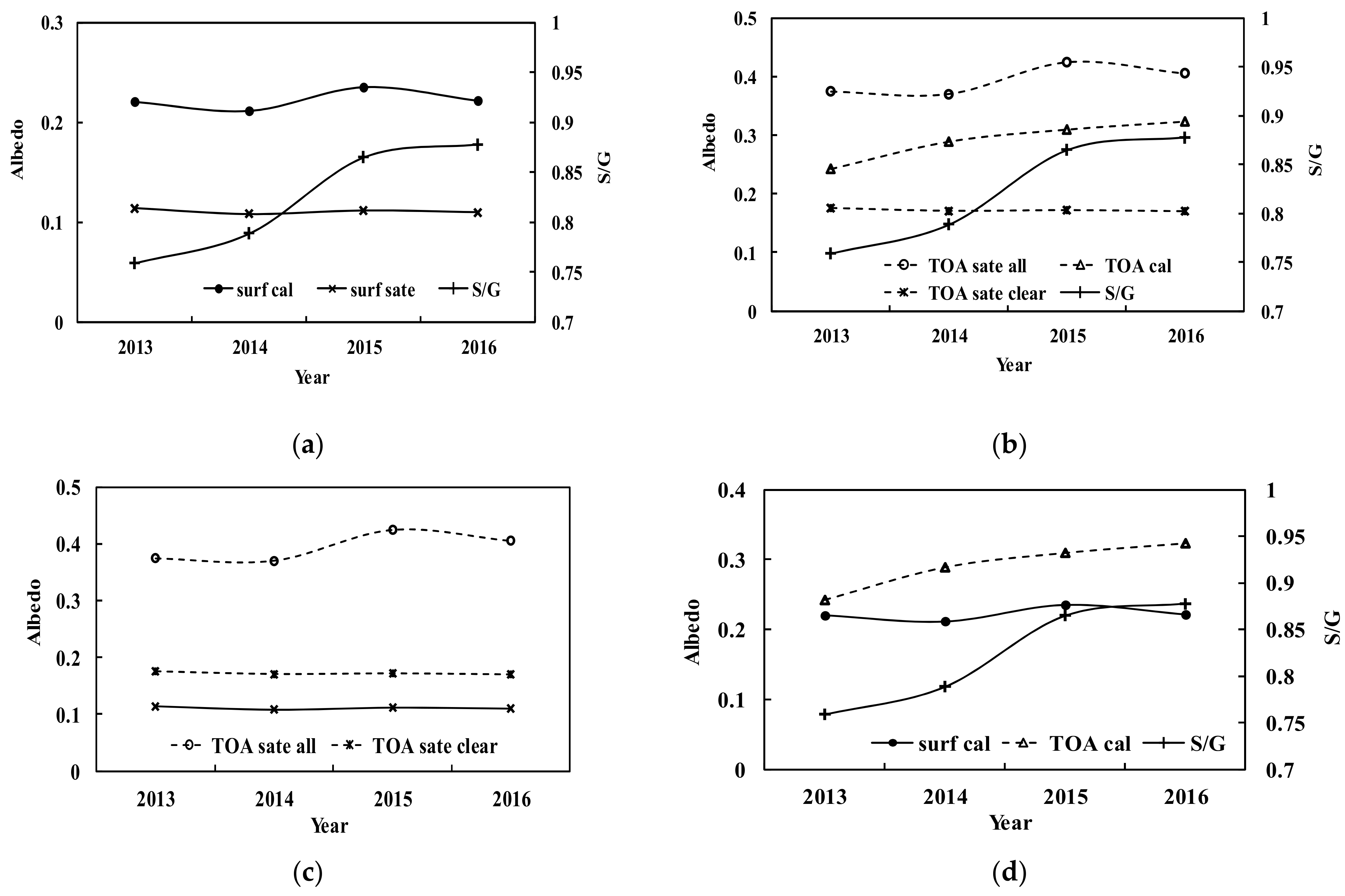
| S/G | A1 | A2 | A0 | R2 | δavg | δmax | NMSE | σcal | σobs | MAD | RMSE | ||
|---|---|---|---|---|---|---|---|---|---|---|---|---|---|
| Range | (MJ m−2) | (%) | (MJ m−2) | (%) | |||||||||
| S/G < 0.80 | 3.89 | 1.04 | −1.04 | 0.69 | 8.73 | 42.42 | 0.02 | 0.32 | 0.39 | 0.15 | 8.68 | 0.23 | 13.38 |
| S/G ≥ 0.80 | 3.89 | 0.32 | −1.07 | 0.54 | 21.26 | 62.79 | 0.05 | 0.32 | 0.44 | 0.25 | 19.26 | 0.30 | 23.57 |
| Season | n | GLA | GLS | GL | GLA | GLS | GL | RLA | RLS | E | S/G |
|---|---|---|---|---|---|---|---|---|---|---|---|
| (MJ m−2) | (W m−2) | ||||||||||
| Spring | 4 | 2.06 | 0.52 | 2.58 | 571.65 | 144.62 | 716.27 | 79.72 | 20.28 | 9.80 | 0.74 |
| Summer | 1 | 1.36 | 0.42 | 1.78 | 377.00 | 117.21 | 494.21 | 76.28 | 23.72 | 20.50 | 0.78 |
| Autumn | 6 | 1.39 | 0.49 | 1.88 | 386.38 | 137.05 | 523.43 | 73.86 | 26.14 | 33.78 | 0.68 |
| Winter | 3 | 1.75 | 0.52 | 2.26 | 485.85 | 143.11 | 628.95 | 77.21 | 22.79 | 24.37 | 0.72 |
| Average | 1.64 | 0.49 | 2.13 | 455.22 | 135.50 | 590.72 | 76.77 | 23.23 | 22.11 | 0.73 | |
| Season | n | GLA | GLS | GL | GLA | GLS | GL | RLA | RLS | E | S/G |
|---|---|---|---|---|---|---|---|---|---|---|---|
| (MJ m−2) | (W m−2) | ||||||||||
| Spring | 6 | 2.06 | 0.18 | 2.24 | 571.59 | 49.87 | 621.46 | 91.93 | 8.07 | 10.67 | 0.87 |
| Summer | 8 | 1.43 | 0.18 | 1.61 | 398.38 | 50.06 | 448.44 | 88.82 | 11.18 | 21.58 | 0.90 |
| Autumn | 6 | 1.36 | 0.16 | 1.52 | 378.52 | 43.28 | 421.80 | 89.76 | 10.25 | 32.05 | 0.86 |
| Winter | 9 | 1.89 | 0.13 | 2.02 | 525.19 | 37.02 | 562.22 | 93.41 | 6.59 | 21.98 | 0.90 |
| Average | 1.69 | 0.16 | 1.85 | 468.42 | 45.06 | 513.48 | 90.98 | 9.02 | 21.57 | 0.88 | |
| S/G Range | GLA | GLS | GL | GLA | GLS | GL | RLA | RLS |
|---|---|---|---|---|---|---|---|---|
| (MJ m−2) | (W m−2) | |||||||
| S/G < 0.80 | 1.66 | 0.39 | 2.04 | 459.95 | 107.44 | 567.40 | 80.99 | 19.11 |
| S/G ≥ 0.80 | 1.69 | 0.13 | 1.82 | 469.46 | 36.90 | 506.36 | 92.41 | 7.59 |
| S/G Range | GLA | GLS | GL | GLA | GLS | GL | RLA | RLS |
|---|---|---|---|---|---|---|---|---|
| (MJ m−2) | (W m−2) | |||||||
| S/G < 0.80 | 1.66 | 0.50 | 2.16 | 459.96 | 139.10 | 599.05 | 76.42 | 23.58 |
| S/G ≥ 0.80 | 1.69 | 0.16 | 1.85 | 469.46 | 44.57 | 514.03 | 91.08 | 8.92 |
| Methods of Using S/G | Gobs MJm−2 | GA MJm−2 | GS MJm−2 | G MJm−2 | GA Wm−2 | GS Wm−2 | G Wm−2 |
| S/G < 0.80 n = 14, S/G | 1.70 | 2.19 | 0.54 | 1.70 | 609.05 | 150.94 | 471.99 |
| S/G ≥ 0.80 n = 29, S/G | 1.29 | 2.20 | 0.16 | 1.29 | 611.68 | 44.05 | 357.62 |
| S/G < 0.80 n = 14, AF method | 1.70 | 2.19 | 0.66 | 1.81 | 609.05 | 182.58 | 503.63 |
| S/G ≥ 0.80 n = 29, AF method | 1.29 | 2.20 | 0.19 | 1.32 | 611.68 | 51.72 | 365.29 |
| Methods of Using S/G | RA % | RS % | E hPa | S/G | |||
| S/G < 0.80, n = 14 S/G | 79.92 | 20.08 | 23.96 | 0.71 | |||
| S/G ≥ 0.80, n = 29 S/G | 93.16 | 6.84 | 21.61 | 0.89 | |||
| S/G < 0.80, n = 14 AF method | 76.77 | 23.23 | 23.96 | 0.71 | |||
| S/G ≥ 0.80, n = 29 AF method | 92.00 | 8.00 | 21.61 | 0.89 | |||
| E (%) | |||||||
| +20 | +40 | +80 | +160 | −20 | −40 | −80 | −100 |
| −2.48 | −4.70 | −8.53 | −14.69 | 2.86 | 6.27 | 16.88 | 43.75 |
| S/G (%) | |||||||
| +20 | +40 | +80 | +160 | −20 | −40 | −80 | −100 |
| −4.41 | −8.22 | −14.39 | −22.50 | 5.09 | 10.96 | 25.59 | 34.65 |
| S/G Range | n | G–T | G–E | G–S/G | G–v | G–v2 | AT–T | ST–v | ST–v2 | S/G–v | S/G–v2 |
|---|---|---|---|---|---|---|---|---|---|---|---|
| S/G < 0.75 | 10 | +0.95 | +0.89 | −0.75 | +0.68 | +0.65 | +0.96 | +0.54 | +0.55 | −0.63 | −0.63 |
| S/G < 0.80 | 14 | +0.94 | +0.89 | −0.67 | +0.54 | +0.54 | +0.87 | +0.53 | +0.52 | −0.46 | −0.50 |
| S/G ≥ 0.80 | 29 | +0.87 | +0.79 | −0.55 | +0.59 | +0.57 | +0.80 | −0.08 | −0.02 | −0.57 | −0.58 |
| Situation | n | B1 | B2 | Bo | R | AF δavg | AF δmax | AOD δavg | AOD δmax | AOD | G | S/G |
|---|---|---|---|---|---|---|---|---|---|---|---|---|
| A | 43 | 0.036 | 0.667 | 0.113 | 0.834 | 16.20 | 53.34 | 53.49 | 129.37 | 0.54 | 1.42 | 0.83 |
| B | 21 | 0.034 | 0.754 | 0.045 | 0.914 | 9.31 | 30.23 | 23.96 | 45.12 | 0.59 | 1.36 | 0.84 |
| C | 43 | 50.86 | 129.51 | 0.54 | 1.42 | 0.83 |
Publisher’s Note: MDPI stays neutral with regard to jurisdictional claims in published maps and institutional affiliations. |
© 2021 by the authors. Licensee MDPI, Basel, Switzerland. This article is an open access article distributed under the terms and conditions of the Creative Commons Attribution (CC BY) license (http://creativecommons.org/licenses/by/4.0/).
Share and Cite
Bai, J.; Zong, X. Global Solar Radiation Transfer and Its Loss in the Atmosphere. Appl. Sci. 2021, 11, 2651. https://doi.org/10.3390/app11062651
Bai J, Zong X. Global Solar Radiation Transfer and Its Loss in the Atmosphere. Applied Sciences. 2021; 11(6):2651. https://doi.org/10.3390/app11062651
Chicago/Turabian StyleBai, Jianhui, and Xuemei Zong. 2021. "Global Solar Radiation Transfer and Its Loss in the Atmosphere" Applied Sciences 11, no. 6: 2651. https://doi.org/10.3390/app11062651
APA StyleBai, J., & Zong, X. (2021). Global Solar Radiation Transfer and Its Loss in the Atmosphere. Applied Sciences, 11(6), 2651. https://doi.org/10.3390/app11062651






